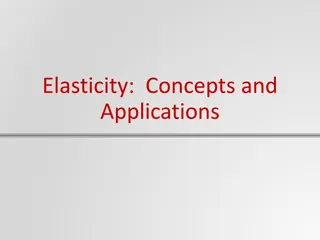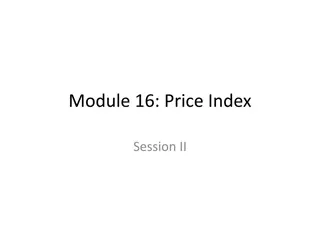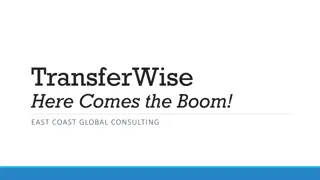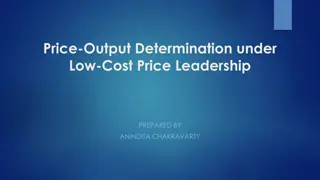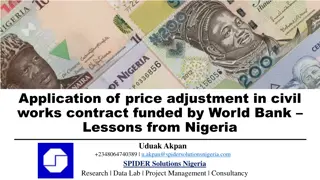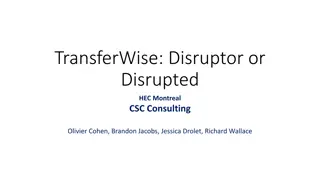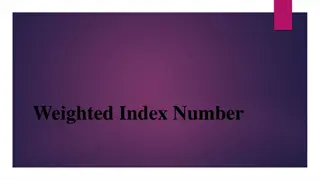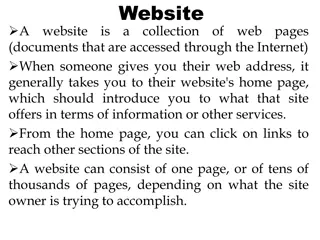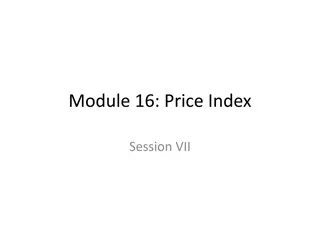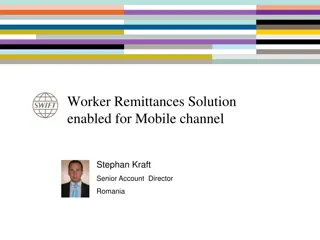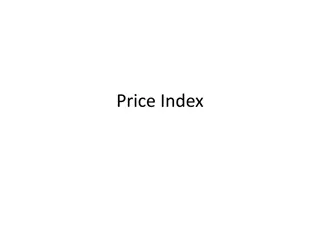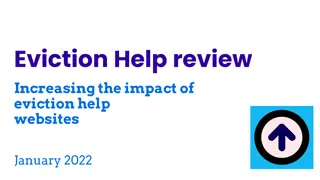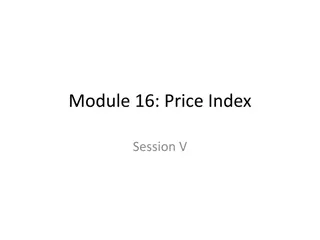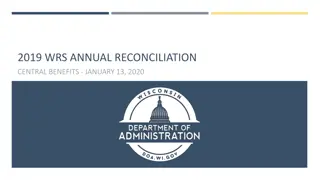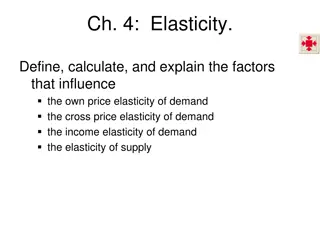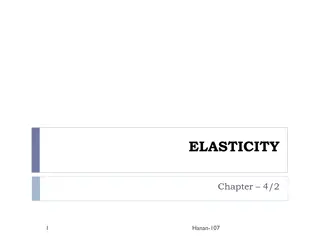Enhancing Remittance Data through Price Comparison Websites
This document discusses the potential role and benefits of using remittance price comparison websites like World Bank's Remittance Prices Worldwide (RPW) database, GeldtransFAIR.de, and RemitRight.com. It covers the types of data provided, pricing trends, user profiles, and provider choices. The RPW database, launched in 2008, is a key tool for tracking remittance costs across major corridors. It also highlights RPW's coverage of forced displacement situations, including data on top refugee host and source countries.
Download Presentation

Please find below an Image/Link to download the presentation.
The content on the website is provided AS IS for your information and personal use only. It may not be sold, licensed, or shared on other websites without obtaining consent from the author. Download presentation by click this link. If you encounter any issues during the download, it is possible that the publisher has removed the file from their server.
E N D
Presentation Transcript
Improving the Evidence Base: Potential Role of Remittance Price Comparison Websites February 12, 2016 KNOMAD Workshop on Measuring Remittances Sent to and from refugees and IDPs Alana Fook and Marco Nicol Lotte Nordhus Charlie Gillig
Content Existing data, possible implications and challenges: I. World Bank Remittance Prices Worldwide (RPW) Database remittanceprices.worldbank.org II. German government-led portal for migrants, GeldtransFAIR.de III. US-based portal for migrants, RemitRight.com
Overview Types of data from the three websites Price developments and conditions and comparison among countries Product and provider availability usage of comparison websites by migrants profiles of the users Provider choices of users RPW provides data analysis relevant for national websites that offer services to migrants relevant for portals that are linked to provider s websites (e.g. RemitRight)
I. RPW Introducing Remittance Prices Worldwide (RPW) RPW Basics Launched in 2008 by the World Bank Served as the primary source of data to track progress towards G8- and G20-endorsed 5x5 objective Remains a key tool to measure the cost incurred by remitters when sending money along major remittance corridors Coverage was recently increased from 227 corridors to 300 WB also certifies other national, regional and private sector databases RPW Coverage Q4 2015 35 99 Sending countries Receiving countries 300 Corridors
I. RPW RPW Coverage of Forced Displacement: Refugees Top 10 Refugee Host Countries (57% of refugees) Turkey Pakistan Lebanon Iran Ethiopia Jordan RPW Coverage Top 10 Refugee Source Countries (77% of all refugees) Syrian Arab Republic Afghanistan Somalia Sudan South Sudan Democratic Republic of Congo Myanmar RPW Coverage Yes (Receiving) Yes (Receiving) Yes (Receiving) Not included Yes (Receiving) Yes (Receiving) Yes (Receiving) Yes (Receiving) Yes (Receiving) Yes (Receiving) Not included Yes (Receiving) Kenya Yes (Sending and Receiving) Not included Yes (Receiving) Yes (Receiving) Yes (Receiving) Chad Uganda China Central African Republic Not included Iraq Eritrea Not included Yes (Receiving)
I. RPW RPW Coverage of Forced Displacement: IDPs Top IDP Countries RPW Coverage Syrian Arab Republic Colombia Iraq Sudan DR Congo Pakistan South Sudan Somalia Nigeria Turkey Yes (Receiving) Yes (Receiving) Not included Yes (Receiving) Yes (Receiving) Yes (Receiving) Not included Yes (Receiving) Yes (Receiving) Yes (Receiving) *RPW covers international remittances (cross-border, person-to-person transfers of relatively low value) so transfers concerning refugees are likely to be more relevant, though IDPs may certainly receive remittances from outside the country.
I. RPW RPW Data What data can we extract? What could it mean? Number and type of Remittance Service Providers (RSPs) serving particular corridors Number, type and relative costs of services offered to send money to and from countries affected by forced displacement Range of average total cost in a given corridor or for a particular type of service These data points could be interpreted to give an indication of several characteristics of the market, including: Market size Level of competition Degree of innovation
I. RPW Challenges with Interpreting Data RPW does not include ALL available services for a given country or corridor, rather the aim is to represent the market trends It is difficult to distinguish which services are used by refugees and IDPs, so average costs may not reflect realities Number, type of RSPs facilitating transfers to and from affected countries, as well as the number, type and cost of their services are a function of several factors, including: Payment system infrastructure in sending and receiving countries (quality, accessibility, interoperability) Legal and regulator environment (access to payment system, licensing requirements, AML/CFT requirements etc) Levels of financial inclusion and education in both countries Migration patterns, including economic migration and forced displacement Time of the year (cost only)
II. GeldtransFAIR.de GeldtransFAIR.de: Existing Data and Limitations Existing Data Quantitative Data Price developments / average and range per corridor, disaggregated by method of transfer, product type, etc. Development of provider availability /number of MTOs per corridor Usage of comparison websites/clicks per corridor Qualitative data: user comments on Facebook and via E-Mail interviews with remittances senders using the platform on events
II. GeldtransFAIR.de GeldtransFAIR.de: Existing Data and Limitations Limitations Prices, conditions and providers updated every 2 months Average prices of all providers in the list, no data on providers used by migrants in Germany No data on internal remittances corridors relevant to refugees and IDPs only included if a large migrant group is residing in Germany List of MTO without online presence might not be exhaustive No quantitative data on users (e.g. origin/migratory status/nationality)
II. GeldtransFAIR.de Preliminary analysis of GeldtransFAIR.de data: corridors and prices relevant for refugees and IDPs Price Development of MTOs per Corridor and of Banks 40 35 average costs for transferring EUR 150 GER-AFG 30 GER-JOR 25 GER-NGA 20 GER-UKR 15 GER-SYR 10 Banks 5 0
II. GeldtransFAIR.de Preliminary analysis of GeldtransFAIR.de data: Service availability for refugees/IDPs Number of MTOs per remittance corridor 10 9 8 GER-AFG 7 number of MTO GER-JOR 6 GER-NGA 5 GER-UKR 4 GER-SYR 3 2 1 0 *GER SYR: Syria was only added to the website in December 2015.
II. GeldtransFAIR.de Preliminary analysis of GeldtransFAIR.de data: usage of the website per country Amount of hits per month and per corridor 700 600 500 Ukraine hits per month Nigeria 400 Afghanistan 300 Jordan Syrien* 200 100 0 Oct 14 Dec 14 Feb 15 Apr 15 Jun 15 Aug 15 Oct 15 Dec 15 Jan 16 *GER SYR: Number of clicks per corridor also includes clicks on information subpage on sending remittances to Syria.
II. GeldtransFAIR.de GeldtransFAIR.de: Potentials for further data generation Pop-up surveys among users Questionnaires via Social Media and on Events
III. RemitRight RemitRight: What data do we extract? Real-time data for digital providers (not brick and mortar) Number and type of digitalRemittance Service Providers (RSPs) serving particular corridors Number of users who select particular MTO s, how much they send and whether and how they transact after leaving RemitRight Information on all data points when remittance sender selects MTO, including f/x rate, transaction fee, send and receive methods, speed at time of decision Demographic info on users including gender, age, country of origin
III. RemitRight RemitRight: Future Questions Answered Collect real-time data on focus refugee corridors including number of providers, prices, services offered both digital and brick and mortar What factors affect refugee remittance decision- making? How does refugee remittance decision making differ from other remittance senders? How does refugee digital decision-making differ from brick and mortar? How do comparison tools affect remittance behavior? Does the number of providers change for these corridors post-influx? Does it change over time?






